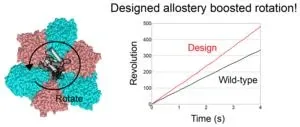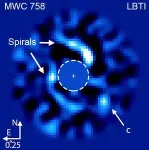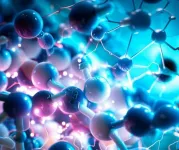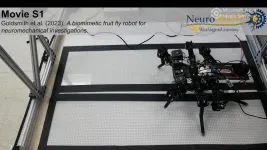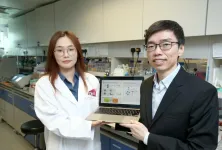Scientists develop strategy to engineer artificial allosteric sites in protein complexes
Work has applications in industry, biology, medicine, and agriculture
2023-07-06
(Press-News.org) According to a recently published research paper by a team of scientists, a groundbreaking approach has been developed to create artificial allosteric sites (where by binding an effector molecule, activity at the distal active site is regulated) in protein complexes. This breakthrough research holds significant promise for a wide range of applications in industrial, biological, medical, and agricultural fields.
The team’s work is published in Nature Chemistry on 06 July 2023 at 16:00 (London time)
Protein complexes, such as hemoglobin and molecular motors, exert concerted functions through cooperative work between the subunits (constituent proteins in the protein complex). This orchestration is enabled by the allosteric mechanism. Allosteric effect, regulation of function at an active site in a subunit by the binding of an effector molecule to an allosteric site in another subunit, was originally proposed in the 1960s and since then it has remained one of the most important topics in the biochemistry field. The research team developed a strategy for designing artificial allosteric sites into protein complexes to regulate a concerted function of a protein complex. “The creation of artificial allosteric sites into protein complexes has the potential to reveal fundamental principles for allostery and serve as tools for synthetic biology,” said Nobuyasu Koga, a professor at the Osaka University.
The research team hypothesized that allosteric sites in protein complexes can be created by restoring lost functions of the pseudo-active sites which are predicted to have been lost during evolution. Various protein complexes include subunits that have pseudo-active sites. It has been reported that pseudo-active sites have an allosteric connection with active sites in other subunits. For example, a pseudo-active site in a subunit, which has lost ATPase activity but still exhibits ATP-binding ability, activates another subunit’s active site upon binding to ATP. (At the cellular level, ATP is the source of energy. ATPase describes the enzyme’s ability to decompose ATP.) Such studies support the idea that distinct allosteric sites can be created into protein complexes by engineering pseudo-active sites.
The research team used computational design to restore the lost ATP-binding ability of the pseudo-active site in the B-subunit of a rotary molecular motor, V1-ATPase (Fig. 1). First, binding ability of the designed site was experimentally revealed by X-ray crystallography. “The X-ray structure indicated the binding site is successfully designed and integrated into the natural protein to have a function. I was amazed at the utility with high performance of protein design technology.” said Mikio Tanabe, an associate professor at the Institute of Materials Structure Science. Next, their single-molecule experiments with X-ray crystallography analyses revealed that the binding of ATP to the designed allosteric site boosts this V1’s activity compared to the wildtype, and the rotation rate can be tuned by modulating the ATP’s binding affinity. The team created cooperativity in the rotary motor. Moreover, the team’s designed allostery accelerated, not decelerated, the rotation, compared to the wildtype (Fig. 2). “To our best knowledge, acceleration of a rotary molecular motor by protein engineering is a first time achievement. This is an exciting result in the field.” said Ryota Iino a professor at the National Institutes of Natural Sciences.
Pseudo-active sites are widespread in nature, and their approach shows promise as a means of programming allosteric control over concerted functions of protein complexes. In addition, the protein design method would enable not only to restore the lost function but also to design binding sites for other ligands. “Our strategy enables us to create allosteric sites into various kinds of protein complexes in principle. Our next step is to create allosteric control for a variety of protein complexes by our strategy. Moreover, we will try to design novel functions into pseudo-active sites. One of our goals is to artificially control concerted functions of any protein complexes and to uncover the general mechanism of allostery. We hope allosteric control over concerted functions of protein complexes will open up new avenues in industrial applications of enzymes or biological, medical and agricultural fields,” said Takahiro Kosugi an assistant professor at the National Institutes of Natural Sciences.
The research team includes Takahiro Kosugi from the Institute for Molecular Science (IMS) National Institutes of Natural Sciences (NINS), the Exploratory Research Center on Life and Living Systems (ExCELLS) NINS, SOKENDAI (The Graduate University for Advanced Studies), and PRESTO Japan Science and Technology Agency; Tatsuya Iida and Ryota Iino from IMS NINS and SOKENDAI; Mikio Tanabe from the Institute of Materials Structure Science, High Energy Accelerator Research Organization (KEK); and Nobuyasu Koga from IMS NINS, ExCELLS NINS, SOKENDAI, and the Osaka University.
This research is funded by a Grant-in-Aid for Scientific Research on Innovative Areas “Molecular Engine”, Japan Science and Technology Agency “Precursory Research for Embryonic Science and Technology”, and the National Institute for Natural Sciences, Okazaki Institute for Integrative Bioscience. Diffraction experiments for X-ray crystallography were performed at the KEK Photon Factory BL-1A partly supported by AMED-BINDS. The computation was performed using Research Center for Computational Science, Okazaki, Japan.
END
ELSE PRESS RELEASES FROM THIS DATE:
2023-07-06
A new study by researchers at the University of Cambridge reveals a surprising discovery that could transform the future of electrochemical devices. The findings offer new opportunities for the development of advanced materials and improved performance in fields such as energy storage, brain-like computing, and bioelectronics.
Electrochemical devices rely on the movement of charged particles, both ions and electrons, to function properly. However, understanding how these charged particles move together has presented a significant challenge, hindering progress in creating new materials for these devices.
In ...
2023-07-06
Many Americans can trace some lines of their family tree back to the 1600s. However, African Americans descended from enslaved Africans, who began arriving in North America in 1619, lack ancestral information spanning several centuries.
A new USC and Stanford study, recently published in Genetics, provides insight into who occupies these missing branches of family trees — and gives a glimpse of how many branches there are.
“Slavery was not that many generations ago, so my family still tells stories about our enslaved ancestors, like who they were and, in my case, how we ended up as light as we are,” said first author Jazlyn Mooney, the Gabilan Assistant Professor of Quantitative ...
2023-07-06
Depictions of the Milky Way show a coiling pattern of spiral "arms" filled with stars extending outward from the center. Similar patterns have been observed in the swirling clouds of gas and dust surrounding some young stars – planetary systems in the making. These so-called protoplanetary disks, which are the birthplaces of young planets, are of interest to scientists because they offer glimpses into what the solar system may have looked like in its infancy and into how planets may form in general. Scientists have long thought that spiral arms in these disks ...
2023-07-06
HOUSTON – A new study led by researchers at The University of Texas MD Anderson Cancer Center provides a deeper understanding of the evolution of the tumor microenvironment during gastric cancer progression. Highlights of the study, published today in Cancer Cell, include a link between multicellular communities and clinical outcomes as well as a potential new therapeutic target.
Gastric adenocarcinoma is one of the most lethal cancers worldwide due to inherent treatment resistance, but the cellular and molecular mechanisms involved in the progression from early pre-cancer to tumor formation and metastasis are not well understood. This research sheds light on how the various ...
2023-07-06
SAN FRANCISCO — PLOS today is announcing that it has extended the scope of its “Accessible Data” experiment, which was first launched in March 2022, with support from a Wellcome Trust grant. The experimental “Accessible Data” feature is designed to increase research data sharing and reuse by highlighting links to select repositories with an eye-catching icon on the article page. We are now expanding from the original three repositories to nine, which together host about three quarters of the outputs linked to from PLOS articles.
PLOS began its Accessible Data experiment with two overarching goals. First, to increase reuse of datasets linked to PLOS articles ...
2023-07-06
Researchers have combined research with real and robotic insects to better understand how they sense forces in their limbs while walking, providing new insights into the biomechanics and neural dynamics of insects and informing new applications for large legged robots.
Campaniform sensilla (CS) are force receptors found in the limbs of insects that respond to stress and strain, providing important information for controlling locomotion. Similar force receptors exist in mammals known as Golgi tendon organs, suggesting that understanding the role ...
2023-07-06
Obesity risk genes make people feel hungrier and lose control over their eating, but practicing dietary restraint could counteract this.
New research by University of Exeter, Exeter Clinical Research Facility, and University of Bristol – funded by the Medical Research Council Doctoral Training Partnership and published in the International Journal of Epidemiology - found that those with higher genetic risk of obesity can reduce the effects that are transmitted via hunger and uncontrolled eating by up to half through dietary restraint.
Psychology PhD student, Shahina Begum, from the University of Exeter is lead author and said: “At a time when high ...
2023-07-06
Researchers have discovered the most distant active supermassive black hole to date with the James Webb Space Telescope (JWST). The galaxy, CEERS 1019, existed about 570 million years after the big bang, and its black hole is less massive than any other yet identified in the early universe.
In addition to the black hole in CEERS 1019, the researchers identified two more black holes that are on the smaller side and existed 1 billion and 1.1 billion years after the big bang. JWST also identified eleven galaxies that existed when the universe was 470 million to 675 million years old. The evidence was provided ...
2023-07-06
Viruses in man-made environments cause public health concerns, but they are generally less studied than bacteria. A recent study led by environmental scientists from City University of Hong Kong (CityU) provided the first evidence of frequent interactions between viruses and bacteria in man-made environments. It found that viruses can potentially help host bacteria adapt and survive in nutrient-depleted man-made environments through a unique gene insertion.
By understanding these virus–bacteria interactions and identifying the possible spread of antibiotic ...
2023-07-06
The American Society for Biochemistry and Molecular Biology sent feedback in June to the National Institutes of Health about its proposed changes to the Ruth L. Kirschstein National Research Service Award fellowship application and review process.
The proposed changes indicate that the NIH adopted nearly all of the ASBMB’s earlier recommendations (here and here) to reduce institutional and investigator bias and refocus the evaluation on an applicant’s potential and the impact of the ...
LAST 30 PRESS RELEASES:
[Press-News.org] Scientists develop strategy to engineer artificial allosteric sites in protein complexes
Work has applications in industry, biology, medicine, and agriculture

